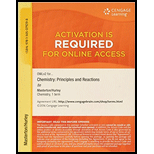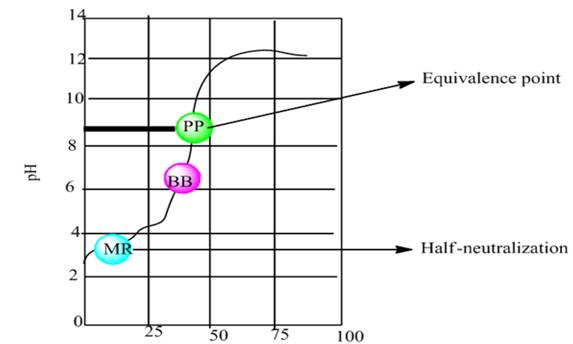
Concept explainers
Fifty cm3 of 1.000 M nitrous acid is titrated with 0.850 M NaOH. What is the pH of the solution
(a) before any NaOH is added?
(b) at half-neutralization?
(c) at the equivalence point?
(d) when 0.10 mL less than the volume of NaOH to reach the equivalence point is added?
(e) when 0.10 mL more than the volume of NaOH to reach the equivalence point is added?
(f) Use your data to construct a plot similar to that shown in Figure 14.10 (pH versus volume NaOH added).
(a)
Interpretation:
The titration of NaOH of molarity 0.850 M occurs with nitrous acid of 50 cm3 with molarity 1.000M. The pH value of the solution is to be determined before the addition of NaOH.
Concept introduction:
For a reaction as follows:
The equilibrium constant can be calculated as follows:
The pH of the solution can be calculated as follows:
Answer to Problem 74QAP
The pH value of the solution is 1.62.
Explanation of Solution
The dissociation reaction for the nitrous acid is shown below-
Given that-
Molarity of HNO2 = 1.000M
The dissociation constant, Ka = 6.0×10-4
Consider the x M of HNO2 is ionized. Hence the ICE table is shown below-
| HNO2 | H+ | NO2 - | |
| I (mol) | 1.000 | 0 | 0 |
| C (mol) | -x | +x | +x |
| E (mol) | 1.000 -x | x | x |
Now the dissociation constant Ka is calculated as-
Given that-
[HNO2 ] = 1.000 -x
[H+] = x
[NO2 -] = x
Put the above values in equation (1),
On calculation −
x = 2.42×10-2
The concentration of [H+] = x= [NO2 -] = 2.42×10-2 at equilibrium
Now, the pH value is −
The value of pH = 1.62
(b)
Interpretation:
The pH value of the solution is to be determined at half neutralization.
Concept introduction:
The
The pH of the solution can be calculated as follows:
Answer to Problem 74QAP
The pH value of the solution is 3.22 at half neutralization.
Explanation of Solution
At half neutralization, only half acid will be ionized and the equilibrium concentration of the conjugate base of acid and acid will be equal. Therefore,
Or
And
Ka = 6.0×10-4
The value of pH for the solution = 3.22
(c)
Interpretation:
The pH value of the solution is to be determined at the equivalence point.
Concept introduction:
The molarity of solution is calculated as follows:
Here, number of moles is of solute and volume is of solution.
For a base dissociation reaction,
The base dissociation constant will be:
It is related to acid dissocation constant and ionization constant of water as follows:
The pOH and pH of the solution can be calculated as follows:
Here,
Answer to Problem 74QAP
The pH value of the solution is 8.45 at the equivalence point.
Explanation of Solution
The chemical equation for the reaction between nitrous acid and sodium hydroxide is given as-
The net-ionic equation of the above reaction is −
Number of moles of nitrous acid-
Or
Given that-
Molarity = 1.000M
Volume = 50.0cc = 0.050L
Put the above values in equation (1)
Number of moles of HNO2 = 0.0500 mol
At equivalence point-
Number of moles of NaOH added = initial number of moles of HNO2 = 0.0500 mol
Molarity of the base = 0.850 M
The volume of the base-
Put the values in the above equation-
Volume of base = 0.0588 L
Molarity of NO2 - is calculated as-
Number of moles of HNO2 = 0.0500mol = Number of moles of NO2 -
Total volume = 0.0500L +0.0588L
Put the given values in above equation-
Molarity of NO2 - = 0.459M
Consider the M of NO2 - will be ionized. Hence the ICE table is shown below-
| NO2 - | HNO2 | OH- | |
| I (mol) | 0.459 | 0 | 0 |
| C (mol) | -y | +y | +y |
| E (mol) | 0.459 -y | y | y |
Now the base dissociation constant Kb is calculated as-
Given that-
[NO2 -] = 0.459 −y
[HNO2 ] = y
[OH-] = y
Put the above values in equation (2)
On calculation −
[OH-] = y = 2.79×10-6
Now, the pH of the solution −
And,
(d)
Interpretation:
The volume less than the 0.10 mL of NaOH is added to reach the equivalence point. At this condition, the pH value of the solution is to be determined.
Concept introduction:
The molarity of solution is calculated as follows:
Here, number of moles is of solute and volume is of solution.
Now, from the Henderson −Hasselbalch equation is as follows−
Answer to Problem 74QAP
The pH value of the solution is 5.92, when the volume less than the 0.10mL of NaOH added.
Explanation of Solution
The number of moles of base-
Given that-
Volume = 58.7mL (0.1mL less than 58.8mL)
Molarity = 0.850 M
Put the above values in Equ (1)
Number of moles of base (NaOH) = 0.0499mol
Now, the number of moles of HNO2 −
Now, the number of moles of conjugate base, NO2 -
Now, from the Henderson −Hasselbalch equation −
Or,
On calculation-
(e)
Interpretation:
The volume more than the 0.10mL of NaOH is added to reach the equivalence point. At this condition, the pH value of the solution is to be determined.
Concept introduction:
The molarity of solution is calculated as follows:
Here, number of moles is of solute and volume is of solution.
The pH of the solution can be calculated as follows:
Answer to Problem 74QAP
The pH value of the solution is 10.88 when the volume more than the 0.10mL of NaOH added.
Explanation of Solution
The number of moles of base-
Given that-
Volume = 58.9mL (0.1mL greater than 58.8mL)
Molarity = 0.850 M
Put the above values in equation (1)
Number of moles of base (NaOH) = 0.050082mol
Now, the number of moles of OH- −
Now, pOH-
And
(f)
Interpretation:
The graph is to be plotted by using the calculated data between pH vs. NaOH added.
Concept introduction:
The equivalence point is defined as the point for the titration process at which addition of titrant is enough for the complete neutralization of the analyte.
Half neutralization is defined as the point at which the concentration of weak acid will become equal to its conjugate base.
Explanation of Solution
The graph plot between pH vs. NaOH added is shown below-

According to the graph, the half neutralization point is approximately at pH 2.8 and equivalence point is approximately at pH 8.8
Want to see more full solutions like this?
Chapter 14 Solutions
CHEMISTRY:PRIN.+REACTIONS-OWLV2 ACCESS
- Don't used Ai solutionarrow_forwardPlease correct answer and don't used hand raitingarrow_forward↑ 0 Quiz List - RCC430M_RU05 X Aktiv Learning App × Qdraw resonance structure ×Q draw resonance structure xb My Questions | bartleby ×+ https://app.aktiv.com Draw a resonance structure of pyrrole that has the same number of pi bonds as the original structure. Include all lone pairs in your structure. + N H a 5 19°F Cloudy Q Search Problem 12 of 15 Atoms, Bonds and Rings Charges and Lone Pairs myhp हजु Undo Reset Remove Done Submit Drag To Pan 2:15 PM 1/25/2025arrow_forward
- Briefly indicate the structure and bonding of silicates.arrow_forward4 Part C Give the IUPAC name and a common name for the following ether: Spell out the full names of the compound in the indicated order separated by a comma.arrow_forwardTry: Draw possible resonance contributing structures for the following organic species: CH3CH2NO2 [CH2CHCH2] [CH2CHCHO] [CH2CHCH2] [CH2CHNH2]arrow_forward
 General Chemistry - Standalone book (MindTap Cour...ChemistryISBN:9781305580343Author:Steven D. Gammon, Ebbing, Darrell Ebbing, Steven D., Darrell; Gammon, Darrell Ebbing; Steven D. Gammon, Darrell D.; Gammon, Ebbing; Steven D. Gammon; DarrellPublisher:Cengage Learning
General Chemistry - Standalone book (MindTap Cour...ChemistryISBN:9781305580343Author:Steven D. Gammon, Ebbing, Darrell Ebbing, Steven D., Darrell; Gammon, Darrell Ebbing; Steven D. Gammon, Darrell D.; Gammon, Ebbing; Steven D. Gammon; DarrellPublisher:Cengage Learning Chemistry: Principles and ReactionsChemistryISBN:9781305079373Author:William L. Masterton, Cecile N. HurleyPublisher:Cengage Learning
Chemistry: Principles and ReactionsChemistryISBN:9781305079373Author:William L. Masterton, Cecile N. HurleyPublisher:Cengage Learning Chemistry: Principles and PracticeChemistryISBN:9780534420123Author:Daniel L. Reger, Scott R. Goode, David W. Ball, Edward MercerPublisher:Cengage Learning
Chemistry: Principles and PracticeChemistryISBN:9780534420123Author:Daniel L. Reger, Scott R. Goode, David W. Ball, Edward MercerPublisher:Cengage Learning World of Chemistry, 3rd editionChemistryISBN:9781133109655Author:Steven S. Zumdahl, Susan L. Zumdahl, Donald J. DeCostePublisher:Brooks / Cole / Cengage Learning
World of Chemistry, 3rd editionChemistryISBN:9781133109655Author:Steven S. Zumdahl, Susan L. Zumdahl, Donald J. DeCostePublisher:Brooks / Cole / Cengage Learning Chemistry: The Molecular ScienceChemistryISBN:9781285199047Author:John W. Moore, Conrad L. StanitskiPublisher:Cengage LearningChemistry: Matter and ChangeChemistryISBN:9780078746376Author:Dinah Zike, Laurel Dingrando, Nicholas Hainen, Cheryl WistromPublisher:Glencoe/McGraw-Hill School Pub Co
Chemistry: The Molecular ScienceChemistryISBN:9781285199047Author:John W. Moore, Conrad L. StanitskiPublisher:Cengage LearningChemistry: Matter and ChangeChemistryISBN:9780078746376Author:Dinah Zike, Laurel Dingrando, Nicholas Hainen, Cheryl WistromPublisher:Glencoe/McGraw-Hill School Pub Co





